Gary Neal Hansen's Blog, page 32
June 18, 2018
Monday Meditation: RCL Year B, 12th Sunday in Ordinary Time, Mark 4:35-41

 Ludolf Backhuysen, Christ in the Storm on the Sea of Galilee -1695
Ludolf Backhuysen, Christ in the Storm on the Sea of Galilee -1695This Sunday’s lectionary Gospel (Mark 4:35-41) is one I remember puzzling over when I was a university student. I had read it before, probably several times, since I started reading the Bible in high school. Maybe I’d even heard it preached.
But I had never noticed this little story. I had never stopped and really chewed on it, neither to hear the questions it was asking me, nor to hear the answers it suggested.
Those university years prompted me to read more slowly, to genuinely study the Bible, book by book, text by text. I wasn’t studying it the way I would learn to do in seminary a few years later: with ancient languages, or the tools of higher criticism, or informed by the spiritual reading of the Church Fathers and the theological reading of the Reformers. But I was reading carefully, prayerfully, asking questions and digging for answers.
Mark 4:35-41
It’s a simple little story.
After days of healing, and now a long day of teaching by the seaside, Jesus and his friends sail off, leaving the crowd behind. Jesus is beat. He goes to sleep while the accomplished fishermen sail the boat. There is a storm. They wake him up. He stills the wind and waves.
So far so good. It all makes sense.
But then Jesus gets on their case:
Why are you afraid? Have you still no faith? (Mark 4:40, NRSV)
That puzzled me.
Wasn’t it perfectly reasonable for the disciples to be afraid? Their boat was being swamped. They could all die.
Wasn’t it perfectly reasonable for the disciples to wake Jesus up? Maybe he could help. Even if he were an incompetent sailer, they could teach him to bail water or hold a rope — something. How could he just lay there sleeping?
But then maybe their response wasn’t so reasonable. They were the first to scold, waking Jesus up with reproof:
Teacher, do you not care that we are perishing? (Mark 4:38, NRSV)
Why do they expect him to be aware of their danger? He was, after all, asleep.
You see their fear and lack of trust in their accusation. They think he doesn’t care.
Still: Jesus seems to really scold them.
He scolds them for being afraid.
He scolds them for lack of faith.
At a glance it seems kind of mean. When my children are afraid, my job is to comfort them, to assure them, to help them get past it — help them trust that all will be well.
Jesus’ response implies that they have missed a lesson he’s been trying to teach them. The lesson is about faith. And the lesson is about faith’s potential power over fear.
The lesson about faith was not taught during the boat trip in Mark 4:35-41. The lesson about faith was taught from Mark 1:1 to Mark 4:34.
Jesus had put his critics to shame and answered his followers’ curiosity with wisdom.
More to the point, the disciples had seen that Jesus could heal
demon possession,
fever,
leprosy,
paralysis,
a withered limb,
and countless unnamed other ailments.
Nothing was too much for Jesus.
I remember the “Aha!” moment, rushing out to relate my insight to the guys I shared an apartment with.
Jesus had been teaching his disciples to trust him — to trust that he was capable of solving life’s hardest problems. Sure there was a storm on — but Jesus was asleep in the boat.
If Jesus himself could sleep through this storm, all would be well. How could they miss that?
He wanted them to have faith based on what they had seen and experienced of Jesus: If Jesus was with them, they could trust that all would be well.
Jesus was right there.
They could trust.
All would be well.
They had no need to fear.
In retrospect it was obvious. How could I have missed it before? How could I ever miss it again.
Storms still shake our faith.
But then life happens. Right now we are in the midst of storms. And it is hard to trust.
Here’s the storm that has me tossing on the seas, wondering if we’re going to drown:
It’s what’s happening on our southern border.
The real Trump Hotel. pic.twitter.com/PP6nIbzNQR
— Tim Kaine (@timkaine) June 18, 2018
Children are being torn from their parents with cruelty familiar to any student of Germany in the 1930s. In 2018 America it isn’t Jews being rounded up and taken to camps with assurances that they will be fed and cared for. It is the suffering poor yearning to breathe free, the oppressed who seek asylum — people who happen to be of browner skin than the ruling class, and who do not speak English as their mother tongue.
It is ordered from the highest officials of the land, claiming law and biblical authority — misinterpreting both, I might add. And the people hauling others to camps are going to say they were just following orders.
Christians far and wide, at least those who have not sold their souls, cry out that this is wrong, a sin of deepest measure, unjustifiable by any fair and full reading of the Christian scriptures.
What is God doing? Is Jesus asleep in the boat?
We wonder if we can trust — and if we should.
We do need to trust.
And in our text, Jesus seems to tell us that if we trust it can overcome our fear.
So we need to trust. And we need to pray.
And with trust overcoming fear, we can act.
We need to trust that Jesus is awake and acting — knowing he’s most likely to act through us.
Because trust is not the end of the journey in a stormy time. While we trust, because of trust, we need to act.
Dear God, help the children. Help us know how to act.
++++++++++++
My “Monday Meditations” are a personal exploration of the coming Sunday’s Gospel text in the Revised Common Lectionary.
I’d love to send these, and all my other new articles and announcements, straight to your inbox. Just scroll down to the black box with the orange button and subscribe to my weekly(ish) newsletter.
The post Monday Meditation: RCL Year B, 12th Sunday in Ordinary Time, Mark 4:35-41 appeared first on Gary Neal Hansen.
June 11, 2018
Monday Meditation: RCL Year B, 11th Sunday in Ordinary Time, Mark 4:26-34

 CC by Yosemite James 2.0
CC by Yosemite James 2.0I have come to dearly love the parables of the kingdom — all those rich metaphors for how God works in the world, in us, through us, and despite us. I love them even when, like this week, the lectionary wrenches them from their context.
Mark 4:26-34
This week’s little parables come in Jesus’ sermon by the seaside, after he told and explained the Parable of the Sower.
The Gospels tell us that he often preached about the kingdom. I imagine the people pestering him, day after day, to tell them what the kingdom of God is really like.
So he tries to explain, again and again, trying to make comparisons they can understand.
This week Jesus tries two images:
1. The kingdom is like someone who tosses out some seed and hopes for the best.
The kingdom farmer scatters seeds. Then he waits around.
This farmer has no idea how seeds grow, but he’s happy to reap the harvest.
This comes in contrast to the contents of my mailbox when I served as a pastor.
Every day I had shiny fliers and catalogs from the ministry machines. They offered me seemingly guaranteed success through their techniques.
This VBS program
That small group ministry
The other evangelism plan
They were produced by people so very confident that they had The Answers.
They seemed to be doing the work of the kingdom — but Jesus here says a key characteristic of the kingdom is the utter mystery of its growth.
Someone scatters seeds.
He then promptly ignores it.
The seeds do their thing and grow.
And as verse 27 so humiliatingly put it,
he does not know how.”
It just happens. That’s how the earth works. You put good seed in good soil and
SURPRISE!
stuff grows.
The lucky farmer (the blessed farmer?) who tossed seeds around later happily harvests the crop.
That’s kingdom ministry.
Do the good work.
Preach the Word.
Love the people.
Hang out and wait.
Stuff grows.
If you claim you really know how it works, you are being unbiblical.
The biblical view of kingdom ministry? The farmer is steadfastly ignorant of basic principles.
Imagine the denominational newspaper reporter: “When asked how he succeeded, the minister asserted that
he does not know how.”
It is easy to get overburdened with one’s own importance in ministry. I am the one with The Vision, I tell myself — and anyone who will listen. I am doing Big Important Things.
Jesus says the kingdom is not a matter of doing Big Important Things. The kingdom is little stuff growing as it should.
2. The kingdom is like a tiny, insignificant seed, that takes root and becomes something remarkable.
Kingdom work is the planting of small unimportant seeds.
The tiniest seed. That’s all I plant. God does the rest. To quote Jesus , I
do not know how.”
I plant a seed.
The seed is good.
The soil is good.
The rains fall.
The sun shines.
Stuff grows.
I can tell it is kingdom work, not because I planted something wonderful, or because I’m a good planter.
No, I see that it is kingdom work because something wonderful grows — something quite separate from me and my perception.
The mustard seed grows and becomes totally unlike the seed. And it becomes useful in enormously surprising ways. It provides space and safety for other things to grow.
So I plant seeds.
I tell my children the stories of the Bible.
I pray with them, and for them.
The soil is good.
The rains come down, as does the sun.
Stuff grows. I do not know how.
But I’ll watch to see them grow big and strong.
I’ll watch to see how they do things that matter in the world.
I pray they someday provide space and safety for others to grow and thrive.
++++++++++++
I’d love to send these Monday Meditations (along with my other new articles and announcements) straight to your inbox. Scroll down to the black box with the orange button to sign up for my weekly(ish) newsletter and all this will be yours…
The post Monday Meditation: RCL Year B, 11th Sunday in Ordinary Time, Mark 4:26-34 appeared first on Gary Neal Hansen.
June 7, 2018
Letters to a Young Pastor: The Children’s Sermon — Is it Gospel?

 CC by smlp.co.uk 2.0
CC by smlp.co.uk 2.0Dear ______:
Thanks for asking me to clarify. I said something about how children’s sermons often reveal a preacher’s real theology, for good or for ill.
I suspect it is because pastors do not think of the children’s sermon as a sermon. They think of it more as a conversation.
If they have a warm, welcoming, fun and affirming time with the kids then there is gospel in that. That’s the Mr. Rogers Moment I first wrote to you about.
But generally pastors try to put some theological content in the words they speak. They know this is their chance to nurture the faith in children.
Is it Gospel?
The second key question to test to a good children’s sermon by is this: “Is it gospel?”
If you had to define Christian faith by what you hear in children’s sermons, what would you say it all boils down to?
Be kind.
Be nice.
Be obedient.
Parents are often pretty happy with that message. I mean who couldn’t use a little help with crowd control…er… behavior management … er … “raising them up the way that they should go,” and all that.
Isn’t this an application of the second great commandment — to love your neighbor?
Yes. But it is not the whole of the gospel. It is not even the heart of the gospel. It is actually what we call
the law.
Telling Kids about the Grace of God
One time, when preaching some text of Paul or other, I worked the same text into my children’s sermon. I asked them a question:
How many of you think God loves you when you are doing what your parents say to do?
I expanded it a bit with a key example:
For instance, does God love you when you are being kind to your little sister or brother?
Of course all the hands went up.
Then I asked,
How many of you believe God loves you even when you are being MEAN to your sister? Does God love you when you are NOT doing what your parents say to do?
No hands.
Then I told them the gospel:
God loves you, even when you are being mean to your kid sister, and even when you are disobeying your parents. God loves you all the time. That’s what we know because of Jesus. He came to show us God’s love when we were all doing all he wrong things.
The parents were giving me Those Looks. I seriously wondered if I’d be out of a job at the next meeting of the Elders.
But you know what? Kids need to hear the actual gospel. It is where salvation comes from.
When we sit down with the kids on Sunday morning, we tend to forget that “the way that they should go” is actually Jesus. They need to hear the good news of God’s grace in Christ and they need, over time, to learn to trust in him.
Our False Gospel
There are at least three dangers of preaching the false gospel of behavior management to children.
1. At the very least we are mixing up Jesus with our culture’s Santa Claus — you know, the guy who is lurking about in secret, who sees you when you’re sleeping, keeping a list of who’s naughty and who’s nice. We convince the kids that they won’t get anything good if they are on the wrong list.
2. More theologically, we are teaching kids what the New Testament says is specifically NOT the gospel — that our behavior, our “works,” are what makes us righteous and brings us to salvation.
3. In some cases (and pray to God that the numbers are few) we are telling kids who secretly suffer abuse that they still need to obey their abuser, that they must put on a nice face no matter how terrifying their existence.
I’m all for teaching kids to be kind. Learning to love and serve those around us is a very good thing. But that message is not, in fact, the gospel.
Tell kids the real good news about the real Jesus. It’s the only way they are likely to know real forgiveness, real healing, and real faith.
Blessings,
Gary
++++++++++++
I’d love to send all these “Letters to a Young Pastor” straight to your inbox — along with my other new articles and announcements. Just scroll down to the black box with the orange button to subscribe to my weekly(ish) newsletter and all this will be yours…
The post Letters to a Young Pastor: The Children’s Sermon — Is it Gospel? appeared first on Gary Neal Hansen.
June 6, 2018
First Visit to an Orthodox Church (pt. 6): Hearing vs Multi-Sensory

 CC by Nicki Dugan Pogue-SA 2.0
CC by Nicki Dugan Pogue-SA 2.0In this series I have pointed out a bunch of key differences between worship in the Protestant West and in the Orthodox East — architecture, candles, icons, processions and so on.
I fear, though, that even with all these things in mind, many Protestants will have a hard time on a first visit to an Orthodox Liturgy. The differences sort of pile up, leaving a visitor with an acute awareness of being a fish out of water.
Is there some big difference tying all these specifics together?
Well, I’m glad you asked. Yes there is.
Hearing vs Multi-Sensory
When you add up all the little differences you get one huge contrast:
In the West we worship with our ears and our minds.
In the East they worship with all their senses, in the full range of human experience.
Take in what is going on around you in the Liturgy:
Hearing
There is plenty to hear.
The Word will be read and preached, of course, and that will be familiar.
But if you listen to the prayers you will be led to call out to God for all the things Scripture says to pray about.
And if you listen to the hymns you’ll be led to meditate on passages of Scripture, on the wonder of Christ’s resurrection, and on other theologically powerful themes.
But it doesn’t stop at hearing. There is more to take in.
Seeing
There is a vast amount to see, and it is all intended to convey the meaning of the biblical faith.
You look at the icons and see the key people of salvation history, the scenes of biblical history, the men and women who have lived that faith particularly well through the centuries.
And as I said in the previous post, you look at the dramatic action, the enactment of Christ coming to you in Word and Sacrament.
Smelling
Which leads us to the sense of smell.
In an Orthodox Liturgy, or any other Orthodox service, as you see the deacon or priest with the incense burner, you smell the complex scent of the incense.
Your nose enters actively into worship. And since you know that the incense is a biblical image of your prayers ascending to God, your nose is leading you to deeper understanding of the faith.
Tasting
If you were Orthodox, your sense of taste would be actively involved in the Liturgy when you receive Communion.
As a non-Orthodox you might see a brief notice in the bulletin saying you can’t receive the sacrament and feel like this is the one sense that got left out. Unfortunately, this message may be the only clear one you receive as a visitor — though really, they are truly glad you are there.
You may still find your taste buds engaged when people come back from Communion. Someone just might hand you a little cube of bread. Go ahead. Eat it.
This is the “antidoron,” meaning “instead of the gifts.” It is part of a larger loaf from which the bread used in the sacrament was removed. The antidoron is blessed and given out to others in attendance.
Giving the antidoron to visitors is not a universal practice, so I hope you won’t feel too bad if it doesn’t happen.
But in some parishes it is a moving gesture of hospitality. They want you to share God’s blessing.
Touching
Orthodox worshippers find their sense of touch engaged in many ways in the course of the Liturgy.
Most prominently you spend long periods standing. In very traditional parishes you won’t even find pews except along the perimeter of the nave.
It’s a respect thing. Who are we to sit in the presence of the King of Kings?
This is “touch” in a different sense than reaching out your hand to something. You feel it in your body when you stand before God for an hour or more.
And there is a great deal more bodily action to be felt.
As discussed earlier in the series, they will pick up, light, and place candles, make the sign of the cross, and kiss icons before even entering the nave.
When the Great Entrance is taking place you may see people reaching out to touch the priest’s vestments, like the woman who sought healing by touching Christ’s hem.
At the end they will line up to kiss a cross held by the priest.
During the service you may see the faithful bow, kneel, or make prostrations touching their foreheads to the floor.
Especially in a Lenten service with many prostrations, you may well leave worship physically tired.
Why Is Protestant Worship Mostly about Hearing?
So the Orthodox worship with their entire bodies. Protestants tend to mostly listen.
Of course it isn’t an absolute difference. You can probably point to times in Protestant services that drew you to participate in both physical and emotional ways. To say it is all ears and minds is potentially misleading.
But there are strong historical reasons for what I’m saying. Let me explain.
Think back to the origins of Protestantism. Imagine yourself in the early 16th century, when Christianity in the West was all Catholicism. Medieval Catholic worship was primarily a visual experience. And I’m not talking about the pictures and statues.
When they went to a Sunday service, medievals called it “going to see Mass.”
That’s because all the words of the service were in Latin, and you probably spoke English, or German, or French, or whatever. You would sit there and pray, maybe using a devotional book if you were literate and rich.
Then, when the priest said the words consecrating the bread and wine, a bell was rung. You heard that bell and looked up to see him lifting up the elements, now understood to have become the very body and blood of Jesus. You looked, and worshipped, because you were gazing on your Lord.
The Protestants thought this was really problematic. Worshipping something you see, they thought, is dangerously close to idolatry.
And going to a worship service in a language you didn’t understand seemed like a missed opportunity. People needed to hear the Scriptures read, hear the Scriptures explained, interpreted, applied, in a sermon. That way they could better understand, believe, and respond to the call of God.
They thought worship should be about hearing. That’s why the central architectural object was the pulpit. Before amplification, having the preacher high and central was the way to let the Word be heard.
Five centuries later, Protestant worship is still focused on what we hear with our ears, and especially with what hearing leads us to understand with our minds.
Our services can be a bit didactic, a bit talky, a bit cerebral — but hey, we like it that way. We are drawn to engage with the contents of Scripture, learn more, understand better, respond more thoroughly.
Why is Orthodox Worship Multi-Sensory?
We tend to think hearing the Word is so important that we forget that Scripture describes worship in whole-person terms.
Yes, the ears are crucial:
…how are they to believe in one of whom they have never heard? And how are they to hear without someone to proclaim him?” Romans 10.14, NRSV.
But Isaiah found he needed to use his eyes as well — and notice that what his eyes saw was God, and the building, and the furnishings:
In the year that King Uzziah died, I saw the Lord sitting on a throne, high and lofty; and the hem of his robe filled the temple.” Isaiah 6:1, NRSV.
If you keep reading in Isaiah, his physical feeling, even a painful feeling, was part of the worship process:
Then one of the seraphs flew to me, holding a live coal that had been taken from the altar with a pair of tongs. The seraph touched my mouth with it … And I said, ‘Here am I; send me!’” Isaiah 6:6-8, NRSV.
And of course there is the special place of the sense of smell, the incense in the Old Testament:
Aaron shall offer fragrant incense on it; every morning when he dresses the lamps he shall offer it…” Exodus 30.7 NRSV.
And as I’ve mentioned, the fragrance the New Testament teaches about in heaven itself, with all falling down in worship carrying
… golden bowls full of incense, which are the prayers of the saints.” Revelation 5:8 NRSV.
Then there is the sense of taste which can be a metaphor, as in
O taste and see that the Lord is good” Psalm 34.8, NRSV.
But taste, as part of eating, is a required part of New Testament worship by Jesus’ own command passed on to us by the Apostle Paul:
For I received from the Lord what I also handed on to you, that the Lord Jesus on the night when he was betrayed took a loaf of bread, and when he had given thanks, he broke it and said, ‘This is my body that is for you. Do this in remembrance of me.’ In the same way he took the cup also, after supper, saying, ‘This cup is the new covenant in my blood. Do this, as often as you drink it, in remembrance of me.’ ” 1 Corinthians 11:23-25.
There is a vast amount of Scripture one could mine about the use of the senses in proper worship — starting with the vivid descriptions of what God commanded for tabernacle and temple furnishings.
Think of that whole-person worship it as obedience to the great command:
…you shall love the Lord your God with all your heart, and with all your soul, and with all your mind, and with all your strength.” Mark 12.30, NRSV
Or maybe better, think of it as an application of Paul’s instruction:
I appeal to you therefore, brothers and sisters, by the mercies of God, to present your bodies as a living sacrifice, holy and acceptable to God, which is your spiritual worship.” Romans 12:1, NRSV
To Paul, “spiritual worship,” or as other translations have it, “reasonable” or “intelligent” worship, is a matter of the body.
After a while our our emphasis on what we hear and think can seem a little narrow.
So when all this multi-sensory stuff is going on in an Orthodox liturgy, think of it as an invitation to bring God every part of who you are.
++++++++++++
This post is part of a series. To start reading from the beginning, click here.
I’d love to send each new article, plus announcements of new projects and publications, straight to your inbox. Just scroll down to the black box with the orange button and sign up for my weekly(ish) newsletter, and all this will be yours…
The post First Visit to an Orthodox Church (pt. 6): Hearing vs Multi-Sensory appeared first on Gary Neal Hansen.
June 4, 2018
Monday Meditation: RCL Year B, 10th Sunday in Ordinary Time, Mark 3:20-35

 The Gospel for the 10th Sunday in Ordinary time (Mark 3:20-35) is what I think of as a “sandwich” passage.
The Gospel for the 10th Sunday in Ordinary time (Mark 3:20-35) is what I think of as a “sandwich” passage.
A Mark 3:20-35 Sandwich
There are two stories, more or less related, but instead of putting them one after the other (as was the case last week), one story is split in two like slices of bread, with the other one spread in the middle like the PB&J.
Both stories are about misunderstanding and accusation.
The framing story is Jesus and his relatives.
Top slice of bread
Rumor has gone round that Jesus has gone bonkers. That’s the top of the sandwich.
You know: two and a half chapters of healing people of leprosy, other diseases and disabilities, casting out demons. Not to mention preaching about submitting to God as king. Crazy stuff like that.
His family comes to collect him. Maybe they’ll do a little intervention, get him back under control.
Bottom slice of bread
The second slice comes at the end. Jesus declares that his really truly family is anybody who does God’s will.
He doesn’t really disown Mary and whoever else showed up, but he does give them a surprising turn. And he does declare that his followers, then and now, are his close kin.
The tricky thing with the bread of this sandwich is it isn’t just about saying you believe in Jesus. To be Jesus’ brother or sister you need to actually do God’s will.
So what’s the peanut butter?
In between the slices of bread comes another group of accusers. In addition to the crowd and his family, Scribes have turned up to make accusations: Jesus isn’t just crazy, they say. He is actually demonic.
That is, they assert Jesus is casting out demons by demonic power.
You’ve heard about “demonizing” your opponents. It’s a classic propaganda technique. Call them bad names and people can more easily dismiss and condemn them.
In the heart of the passage, Jesus turns the accusation around on them with a bit of poetic theology.
With the sort of parallelisms familiar to any reader of the Psalms and Prophets, he points out that no self-respecting devil would cast out devils. Using the NRSV I suppose I might chart it out like this:
(A) How can Satan cast out Satan?
(B) If a kingdom is divided against itself,
(C) that kingdom cannot stand.
(B’) And if a house is divided against itself,
(C’) that house will not be able to stand.
(A’) And if Satan has risen up against himself
(B”) and is divided,
(C”) he cannot stand,
(D) but his end has come.
No, clearly, Jesus says, he is not casting out the devil with the devil’s power. He has been defeating the devil’s power.
He points out that to plunder someone’s house one first has to capture the owner and tie him up.
That’s a sort of rhetorical device — an “enthymeme” perhaps, a syllogism with the conclusion left off for the audience to figure out.
Conclusion: There’s a new sheriff in town.
Jesus is proclaiming that he has, in fact, entered Satan’s house and tied that bad boy up. That’s why, and how, he can cast out demons.
So then the really juicy jam on this sandwich
The jam is the discussion of the “unforgivable sin,” or “blasphemy agains the Holy Spirit.” It is pretty potent stuff.
A lot of theological and homiletical ink has been spilled about this.
And a lot of sad Christian anxiety has been poured out out about it as well. A lot of people worry that they have somehow placed themselves beyond God’s forgiveness and grace.
The good news: If you are actually worried about this it’s pretty clear that you haven’t done it.
But what is it?
Mark doesn’t want us to miss it — to be as confused about it as we have been for 2000 years. He points out that Jesus only brought up the unforgivable sin, blasphemy against the Holy Spirit, for one reason:
— for they had said, ‘He has an unclean spirit.’”
The Scribes had looked at Jesus, seen what he was doing, and believed that it was the work of Satan.
That is, they looked at God in the flesh, doing good to all, and declared that it was actually evil. Jesus said that was blasphemy against the Spirit.
Here’s what that means:
If you look at light and say it is darkness, you are in a really bad place. If you are convinced “white” is “black” there is little that can be done for you.
Committing the unforgivable sin is not a matter of having done something God has explicitly forbidden — even something really objectively awful.
The unforgivable sin is when you become the kind of person who looks at goodness and believes it to be evil.
So… If you see people doing what Jesus did …
showing kindness and mercy
freely healing sick people
helping the mentally ill find sanity
feeding the poor without asking them to be worthy
welcoming the stranger, the alien, the refugee, the widow, the outcast
… do you call it evil? If you really believe that goodness and mercy are evil, then it is just really hard to find your way to repentance.
I sort of suspect that the opposite may be true as well.
If you look at people doing evil, for instance …
being cruel and unmerciful
withholding healthcare from sick people
not caring about the mentally ill on the streets and in the jails
insisting that to receive help the poor must be “worthy”
rejecting the stranger, the alien, the refugee, the single mom, the outcast
… and call it “good,” this too may leave you in a world of hurt.
The text isn’t quite as explicit about calling evil “good.” But it surely is the reciprocal of calling good “evil” — and it is happening in the world around us. Even among people who say they believe in Jesus.
Maybe in this there is still room for repentance. I hope so.
++++++++++++
I’d love to send you these Monday Meditations (along with my other new articles and announcements) straight to your inbox. Scroll down to the black box with the orange button to sign up for my weekly(ish) newsletter and all this will be yours…
The post Monday Meditation: RCL Year B, 10th Sunday in Ordinary Time, Mark 3:20-35 appeared first on Gary Neal Hansen.
May 29, 2018
Monday Meditation: RCL Year B, 9th Sunday in Ordinary Time, Mark 2:23-3:6

 CC by Keith Evans-SA 2.0
CC by Keith Evans-SA 2.0Ordinary time in Year B of the Revised Common Lectionary brings us back to the Gospel of Mark. I’m glad to be back.
Mark has a straightforwardness, an immediacy, that is always inviting. And it is short enough to read in a pretty easy sitting — a highly recommended practice if you want to see the subtlety underneath the simplicity. Mark seems so plain taken piece by piece as happens on a Sunday morning — but his telling of Jesus’ story is textured, patterned, rich.
Jesus enters with a splash in Mark — which is more than a pun on the baptism with which the Gospel opens. He calls Peter, Andrew, James, and John and then turns to healing — a demon-possessed man, Peter’s mother in law, a nameless crowd, a man with leprosy, a paralyzed man. He jumps into teaching as well, though we don’t hear much of the content. And the Pharisees have already begun to object.
And then we pick up the story in next Sunday’s lectionary text, Mark 2:23-3:6.
Mark 2:23-3:6
The cast is, as Captain Renault put it in Casablanca, “the usual suspects”:
Jesus
His disciples
The Pharisees.
I always like to keep an eye on those Pharisees, by the way. They get some bad press, even in this passage, but they aren’t the cardboard cut-out villains preachers often make them out to be.
I think Jesus really liked them. They are always there, always asking questions, always engaged. I might argue that they were his target audience.
The Sabbath
The issue is the Sabbath — a topic as easy for Christians to misconstrue as the Pharisees.
First Jesus’ friends take gleanings from the grain fields, as is permitted to the poor in the Law of Moses (see Leviticus 23:22 and Deuteronomy 24:21). But it is on the Sabbath, and the Pharisees accuse them of unlawful work.
Second, in the synagogue Jesus encounters a disabled man. For the eagle-eyed pharisees this is a test case: will Jesus do the unlawful work of healing the poor guy?
Do Good, Save Life
Jesus’ teaching that one should do good and save life on the Sabbath was not news to the Pharisees. The mandate to save life is understood by the Talmud to override other specific prohibitions of actions on the Sabbath, and it is rooted in the Law of Moses.
So I need to look more closely to find what Jesus was emphasizing.
I think the thing to notice is that Jesus was interpreting the law to save life even on the Sabbath to include the need to alleviate suffering even on the Sabbath.
Jesus’ actions allowed a deeper rest to weary, suffering people.
What is more wearying and distracting than hunger?
What is more wearying and distracting than a injured or disabled body?
Helping the poor rest from hunger and helping a wounded man find health is fitting for the Sabbath. Feed and heal people and then maybe they can focus on keeping the Sabbath.
This is not to say that every Lord’s Day should be filled with service projects. That’s the temptation of our activist culture. We misinterpret Jesus if we think that Sabbath rest is not required of us. Jesus did not say the Sabbath was unimportant. At the very least he showed up in the synagogue to worship.
If only I can get past the omnipresent (and often anti-semitic) polemics agains the Pharisees, I can look to what guided Jesus’ own actions that Sabbath day.
The Poor, Aliens, Widows, Orphans
What about that gleaning, the picking of grain? Look at the biblical passages I mentioned above:
When you reap the harvest of your land, you shall not reap to the very edges of your field, or gather the gleanings of your harvest; you shall leave them for the poor and for the alien: I am the Lord your God.” (Leviticus 23.22 NRSV)
and
When you gather the grapes of your vineyard, do not glean what is left; it shall be for the alien, the orphan, and the widow.” (Deuteronomy 24.21 NRSV)
Ah yes, my culture and I are challenged here. We want people to pull themselves up by their bootstraps. We would give to the poor, but only if somehow we deem them “worthy.”
God tells me to provide. Just keep less for myself, and let the poor have it:
“aliens”? Think immigrants and asylum seekers;
“orphans” and “widows”? Think single moms and kids in poor families.
Mercy — that’s what God calls me to, even on the Sabbath. I can’t evade the call to show to others the same mercy God has shown me, not even on the Sabbath.
++++++++++++
I’d love to send these Monday Meditations (which are sometimes, like this week, Tuesday Trepidations) straight to your inbox, along with my other articles and announcements. Just scroll down to the black box with the orange button to subscribe to my weekly(ish) newsletter and all this will be yours…
The post Monday Meditation: RCL Year B, 9th Sunday in Ordinary Time, Mark 2:23-3:6 appeared first on Gary Neal Hansen.
May 25, 2018
First Visit to an Orthodox Church (pt. 5): Drama vs Narrative
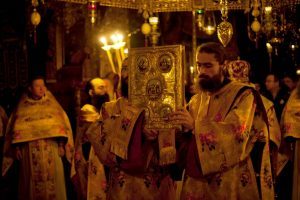
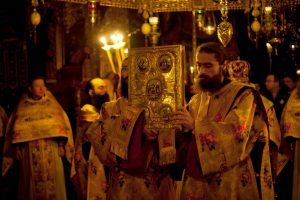 From New Liturgical Movement website
From New Liturgical Movement websiteIf you read last week’s post in this series, you know my musical metaphor: Orthodox worship is to jazz as Western worship is to a singer-songwriter concert.
There are several individuals and groups which, like instruments or sections, pick up important themes in turn, transforming each theme and adding to it.
On your first visit it might seem chaotic, but if you hang in there, you can learn to understand and enjoy the interplay.
But wait,” you say, “I need something to clue me in to the basic shape of the Liturgy. What’s the order, the flow?
I feel your pain.
That’s a very Protestant question. We in the West always expect the service to have a clear order. We try to make it simple, understandable to even the most unchurched first time visitor. If worship leaves anybody confused, we feel like we’ve been inhospitable. We think of it as evangelism — and that is a very good thing.
Drama vs Narrative
We Protestants like a straightforward narrative structure. How straightforward?
In some evangelical churches the service has a simple two-part structure: a time of singing prepares for a time of teaching.
In my mainline denomination worship is a bit more complex, but it unfolds in an order that narrates our faith experience, encountering the God revealed in Scripture:
We “gather around the Word,” with praise, song, and confession.
We hear the Word proclaimed, with the Scriptures read and preached.
We respond to the Word, declaring our faith in Creed and song, in prayers and through offerings.
We experience what we call the “sealing” of the Word when we (sometimes) celebrate the sacraments of baptism and the Lord’s Supper.
We are sent out with the Word into the world, in a charge and benediction.
Each service tells you the story of a basic genuine experience of the faith as an encounter with the Word of God, Jesus Christ. In case you might not pick it up intuitively, we put it in the little bulletin you are given at the door.
Protestant worship is linear, with a clear and graspable pattern. It tells the story of the Christian faith in a nutshell.
In Orthodox worship it is much harder to find a single narrative line. That’s partly because there are actually several time lines unfolding within the same service.
Consider just the music that the choir leads.
There is an eight-week cycle of hymns for Sundays (and for every day of the week).
Then there are hymns sung throughout each season of the Church Year (Advent, Lent and the rest).
A third cycle is hymns that are sung just one day each year to commemorate whatever saint or saints are remembered on that day.
Plus there are a couple hymns that are sung at every Liturgy.
Whew!
Less Narration, More Action
But still, I think I can help you out. The Liturgy really does make sense. You just have to give up looking for a narrative line. Instead you need to watch a drama unfold.
Drama? I mean physical action. Keep your eyes on the guys in the robes (and unless you are at a convent, it’s going to be guys). They will do a lot of marching around.
Once you know what the action is about, you’ll know the most central things about the Liturgy.
Incense
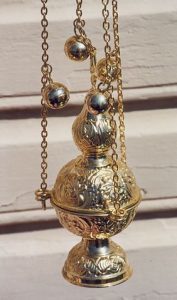 CC by Nina Aldin Thune 2.5
CC by Nina Aldin Thune 2.5First you will see the priest or deacon swinging a golden incense burner. Behind the iconostasis he will swing it toward the altar table, and when he comes into the nave he will swing it toward the icons and the people.
He is enacting a piece of biblical drama.
The Psalmist prayed
May my prayer be set before you like incense” (Psalm 141:2 NIV. 140:2 by the Orthodox numbering).
And in Revelation, in John’s vision of the heavenly throne room, the four living creatures and twenty-four elders fell down in worship, holding
… golden bowls full of incense, which are the prayers of the saints.” (Revelation 5:8 NRSV)
When you see the drama, you begin to catch the meaning. Rather than just being startled by the smell, watch and remember: this is the way Scripture portrays prayer and worship.
There are two bigger points of dramatic movement in the Liturgy. Both are called “entrances” — one “little” and one “great.” Each one embodies the message of the gospel in a different way.
The Little Entrance
The “Little Entrance” happens in the first half of the Liturgy, which is called the Liturgy of the Catechumens. The core action here, in the midst of the hymns and prayers, is the reading and preaching of the scriptures, especially the Gospel.
So what is the drama of the Little Entrance?
The priest will pick up a large book, the Gospels in gold covers. He or the deacon will carry it around the altar table and out into the nave through the North door of the iconostasis. A large or small troop of deacons and acolytes will lead the way and follow behind, carrying a cross, candles, and fans. They will eventually go back through the iconostasis.
But what I want you to focus on is this: the dramatic action shows the Gospel –Christ is coming out to you. The whole good news starts with Jesus, the Word of God coming from heaven, and living in our midst.
One of the most important commentators on the Liturgy, St. Germanus of Constantinople (d. 733), described the Little Entrance this way:
The entrance of the Gospel signifies the coming of the Son of God and His entrance into the world… (On the Divine Liturgy, par. 24)
The Gospel books are where we meet him and they are themselves counted as the Word of God. As Germanus puts it about the reading of the Gospel,
The Gospel is the coming of God, when He was seen by us…. He appeared visibly as a true man. (par. 31)
So the drama enacts coming of the kingdom of God, Christ drawing near. And then, if the church is following the ancient order, there will be a sermon, making that Gospel all the more clear and understandable.
This whole action is for you, even as a visitor — not just for the Orthodox. Jesus comes to us all and he is to be proclaimed to all.
The Great Entrance
The “Great Entrance” is in the second half of the Liturgy, known as “The Liturgy of the Faithful” because in the early Church only baptized Christians could remain in the room for it. This is the portion of the service where the Lord’s Supper is celebrated — and even today, if you are not a member of the Orthodox Church you won’t be able to receive the sacrament.
However, in our enlightened age you can stay and see the drama. (So rather than concentrating on feeling excluded, maybe you can rejoice that we all got a status upgrade.)
Here again in the Eucharistic liturgy the Gospel drama gets enacted. The priest will pick up the bread and wine prior to their consecration, carry them around the altar table, and out through the North door into the nave where the congregation stands. As before he is led and followed by deacons and acolytes.
As St. Germanus put it, this procession and the hymn sung at the time represents the saints, the righteous, and the angels
… who run invisibly in advance of the great king, Christ, who is proceeding to the mystical sacrifice, born aloft by material hands. (Par. 37)
What is the message of the drama of the Great Entrance? It is the gospel again — Jesus comes to us, to save us, to unite us to himself.
It is the same message as when the Gospel book came to us, only now it is more focused: those who have received Christ the Word in faith now are to be joined to him in his Body and Blood.
So What’s the Big Deal?
You may find yourself asking what the big deal is with all this parading around. Well, think of it as a different way of embodying the message than you are used to. More on that in my next post.
For now, try to wrap your mind around the message of the very biblical dramatic action.
Our prayers go up as incense.
Jesus comes to us in the Gospel.
Jesus comes to us in the Eucharist.
Once you see those three things happening physically in the process of worship, you have a place to focus. You can make sense of this whole, very foreign service.
There is more to it. If you start reading the ancient and medieval commentaries on the Liturgy you will find them emphasizing a variety of other layers of meaning.
And that is as it should be. I mean, if you are participating in the activity of God’s heavenly throne room, you are stepping into mysteries beyond human capacity for knowing. You shouldn’t expect to get the whole thing, and certainly not all at once, the very first time.
It is rich. It is complex. It is not user friendly. There is a learning curve.
But what in your life that is worth holding on to is simple and straightforward from day one?
Marriage?
Parenting?
Your vocation?
Your art?
Why should relationship with the God of the universe be less complex?
If worship is the business of heaven, why not take the time to learn?
++++++++++++
This post is part of a series on how to have a good first visit to an Orthodox church. Click here to read from the first entry.
This post contains an affiliate link. If you click through to St. Germanus’ nifty book on Amazon and make a purchase I’ll get a tiny commission.
To get all my new articles and announcements in the comfort of your inbox, scroll down to the black box with the orange button and subscribe to my weekly(ish) newsletter!
The post First Visit to an Orthodox Church (pt. 5): Drama vs Narrative appeared first on Gary Neal Hansen.
May 22, 2018
Monday Meditation: RCL Year B, Trinity Sunday, John 3:1-17

 Christ and Nicodemus by Crijn Hendricksz
Christ and Nicodemus by Crijn Hendricksz(This week’s Monday Meditation is coming out on Tuesday. But I really did write it on Monday. No kidding.)
I love the story of Nicodemus (John 3:1-17), though it is very hard to read it with fresh eyes.
Two verses have their own enormous cultural gravity, pulling the rest of the story in like black holes.
In verse three the call to be “born again” as the old KJV had it (that’s “born from above” in the NRSV) has been fully absorbed into American evangelical culture, along with rather dubious interpretations.
And verse 16 (“For God so loved the world…”) has come to serve as the very definition of the gospel in American Christianity, quoted zealously and often, without context or elaboration to make it explicable to outsiders.
What do I find when I try to think and feel my way through the story?
John 3:1-17
Nicodemus starts by buttering Jesus up with praise. Jesus doesn’t buy it. He cuts instead to what he seems to think is Nicodemus’ deeper issue: being born, “from above”or “again.”
Judging by Nicodemus’ confusion, Jesus hit the mark. Being reborn in a literal, physical sense? That just ain’t gonna happen.
But Jesus is talking spirit stuff here, in metaphors. It is about the Kingdom of God, and you get in only by birth — rebirth, birth from above, by water and Spirit. And this reference to the Spirit, just before his reference to God sending the Son, has made the text our Trinity Sunday lectionary Gospel.
Born Again from Above
Birth by water is the Church’s rite of baptism.
Birth by Spirit is God’s present act of making us new.
Both, really, are “from above” — above the individual, done to us rather than by us. And that is so whether we come to baptism by our parents’ choice or by our own.
God’s action is always from above, out of our reach. Jesus emphasizes this, speaking of the Spirit’s freedom, the mystery of its action. It is not subject to our human willing or even our human knowing. Like the wind, we see the Spirit’s effects (and surely we should always look for them) but our eyes cannot see the thing itself.
Nicodemus is baffled just at this point. I think he doesn’t like the passivity of the Spirit’s work. He’s “a leader of the Jews,” a faithful keeper of the commandments.
He surely didn’t fit the Protestant caricature of trying to “earn” salvation by one’s works, but he did knew what God’s people had to do. Belonging to God was a matter of daily conscious choices, eventually habitual choices, living the obedient life.
But Jesus professes bafflement at Nicodemus’ lack of understanding here. He doesn’t mock him, or blame him. He wants him to know this life at God’s initiative, moved by the free and mysterious Spirit.
Ascension Again
Jesus explains that he is speaking from first-hand personal knowledge. He knows because he has descended from heaven and will ascend (in the text it sounds as if he already has ascended) into heaven. He is the Son sent to save, and his ascent will save as did that of Moses.
Moses lifted up the serpent, and all who looked were saved from death.
Jesus will ascend to where he came from, and by his ascension all will look to him for life and rebirth.
It is a fresh and winsome thing to me that Jesus portrays his ascension, rather than his crucifixion, as the fulfillment foreshadowed by Moses’ brazen serpent in the wilderness.
So I am left meditating on the Ascension again, two and a half weeks later. Jesus was lifted, and now all are to look up to him, in heaven.
Contemplation
The upshot of the whole story is not a catchphrase (“Ye must be born again!”) nor a summary of the gospel (“For God so loved the world…”). Rather it is a call to contemplation.
Contemplation? Isn’t that a Catholic thing?
Actually contemplation is a Christian thing. Catholic, Orthodox, and Protestant. It is just a counter-cultural thing. We live in an activist society, a world where we measure success by doing.
But salvation (reconciliation between God and us, the new relationship growing out of forgiveness, the healing of the whole person you see in Jesus’ ministry) comes in a life of contemplation.
In the fourth century St. Athanasius’ portrayed the work of Christ this way. When we were broken and dead because of sin, Jesus came and restored us — and the purpose of this restoration was a life directed back toward God, toward the source of life, up to heaven rather than down toward death.
Contemplation is turning the eyes of our heart and mind toward God. In the image of this text, we turn toward Christ the Ascended One, and walk daily toward him.
All the good and holy activity, all that is genuinely loving and all that makes for justice and peace, flows from that contemplation.
Lord knows that’s what I need.
++++++++++++
I’d love to send my Monday Meditations (as well as my other articles and announcements) straight to your inbox. Scroll down to the black box with the orange button to sign up for my weekly(ish) newsletter, and all this will be yours…
The post Monday Meditation: RCL Year B, Trinity Sunday, John 3:1-17 appeared first on Gary Neal Hansen.
May 14, 2018
Monday Meditation: RCL Year B, Pentecost, John 15:26-27, 16:4b-15

 CC by Nick Youngson-SA 3.0
CC by Nick Youngson-SA 3.0John 15:26-27, 16:4b-15
As with almost any text in John, the Gospel text for Pentecost (John 15:26-27, 16:4b-15) is evocative, fascinating, and confusing by turns.
Don’t expect me to clear it all up and tie it with a bow for you. These Monday Meditations are just my journey into next Sunday’s Gospel. I hope you’ll come with me even it the road goes into the woods.
Evocative
Under the heading “evocative” come Jesus’ statements about the origin of the Spirit.
The Spirit “comes from the Father” but is “sent” by the Son. An important point of classic (especially Eastern) Trinitarian theology lies here.
This passage agrees with the East, and the original text of the Nicene Creed, where the Spirit where the Spirit “proceeds from the Father.”
This contrasts with the Western editing of the Creed to say the Spirit proceeds from the Father “and the Son.”
Ecumenism still hasn’t overcome that thousand-year-old foundational difference between the Catholic and Orthodox understanding of God — though it isn’t what speaks to me in the text today.
Fascinating
“Fascinating” is my heading for the work of the Holy Spirit here, our “Advocate” who is named in particular the “Spirit of Truth.” This distinctive name seems to indicate Jesus’ understanding of one of the main things the Spirit will do after his ascension.
He has not taught everything that is to be taught. In his absence the Disciples are not left to their own reasoning prowess. Instead God the Holy Spirit will be with them to guide them “into all truth.” This is part and parcel of the work of the Spirit “testifying” to what Jesus has said; taking what belongs to Jesus and declaring it to the disciples.
Jesus said this would actually be better for the disciples, but I’m hard pressed to think they believed him.
But I need the Spirit do do this good work — and clearly the Church as a whole needs it.
It is genuinely difficult to know and hold to the truth in this world. Christians are often at odds with each other on any topic that incites passion.
It is easy to look at the views of large groups of Christians, contrasting them to issues written deeply widely into every part of Holy Scripture, and suspect that these Christians have actually sold their souls.
Better to focus on my own need to stay close to Jesus, to abide in him like a branch in a vine as John 15 earlier emphasized. Then, so close that his life flows in me, I can trust that the Spirit will indeed guide me to truth — even if it comes at the end of a long circuitous path of confusion.
Confusing
And the “confusing” parts?
First, of course, is why the lectionary omits a crucial piece of the middle of the text. (The reason is probably obvious once you read it, but I wish they wouldn’t trim out bits of the Scriptures.)
To my mind the more important bits of confusion are found in Jesus’ reasons for the Spirit’s work of “convicting” or “reproving” the world of sin, righteousness, and coming judgment.
Don’t get me wrong: it seems eminently clear that without the Spirit’s guidance, we will mistake sin for righteousness, and vice versa, on a regular basis. And we’ll completely displace concern with judgment to come with our own deeply held prejudices that those who disagree with us will fall under that judgment.
Whether on the left or the right, we readily take our sense of sin, of righteousness, and of judgement from the culture, or our own subculture. How desperately we need the Spirit’s conviction and reproof as Jesus promised.
But Jesus’ reasons for these things?
Sin because of people’s disbelief in Jesus
Righteousness because of Jesus’ ascension
Judgment because of the condemnation of Satan
There are logical turns here that are inscrutable, only partially explained with insights from Paul and other biblical authors. Many Christians proclaim these things, but I think their confidence exceeds their understanding.
I often find myself glossing past these reasons in verses 9-11, holding fast to the clearer and more helpful declaration that the Spirit does, in fact, bring this clarity.
Wondering
I wonder what I can do to more fully embrace the promised Spirit.
I wonder what I can do to take my understanding of Truth from that Spirit rather than from the world around me.
I wonder what in my life will change when that happens.
++++++++++++
I’d love to send all of these Monday Meditations (along with other new articles and announcements) straight to your inbox. Scroll down to the black box with the orange button to sign up for my weekly(ish) newsletter, and all this will be yours…
The post Monday Meditation: RCL Year B, Pentecost, John 15:26-27, 16:4b-15 appeared first on Gary Neal Hansen.
May 11, 2018
First Visit to an Orthodox Church (pt. 4): Jazz vs Ballads
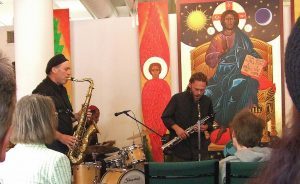
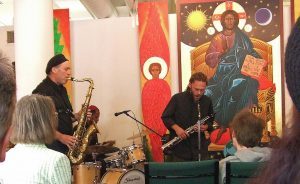 Coltrane Church, CC by Freimut Bahlo-SA 1.0
Coltrane Church, CC by Freimut Bahlo-SA 1.0I asked one Orthodox priest what he thought the typical newcomer would experience when visiting the Liturgy. His response:
Chaos!
He was joking. His congregation has a lot of free-range children.
But I think he was right. Once the service begins in that icon-filled space, your typical Protestant is hard pressed to make much sense of what is going on. Just like a first-time listener to John Coltrane’s Jazz.
(Coltrane, by the way, is regarded as a saint by one sect — though not one that is accepted by the larger Orthodox Church.)
It is confusing even if the whole thing is in English. That is not a given. Many Orthodox parishes have strong ethnic identities, so the service you stumble into might be in any of a half dozen languages.
But let’s assume you checked the website, or called ahead. You understand the language. What is so confusing? Two things:
Time vs Eternity
When I made my third or fourth evening visit to one church’s Vespers service, I was unavoidably delayed. I arrived almost halfway through, and apologized to the priest afterward for being late.
Late?” he said, “What’s ‘late’? There’s no such thing as late.
His face showed that he genuinely meant it, but his eyes were twinkling.
And when you arrive for Liturgy, punctual Protestant that you are, your sense of time will be thrown off. Even if you came five or ten minutes early, people will already be singing, there will be readings, and clergy in vestments will be doing things here and there.
It has begun without you.
Fear not. There is almost always another service in the hour before, and there is no clear pause before the Liturgy begins. Depending on the tradition of the particular church this service might be called “Matins” or “Orthros,” or it might be one of the monastic “Hours.”
There probably aren’t many people there yet — possibly only the Priest and a couple singers at the chant stand. But this pre-service-service will be so elaborate you might be miffed on their behalf.
How could the members just blow this off?
The Orthodox don’t mind. The important thing seems to be to offer praise and prayer to God, and to do it in beautiful ways that honor God. Whether people come or not is secondary.
That’s a contrast to Protestant churches — if people don’t come we think the service is a failure. For the Orthodox it is important just to do it.
This different attitude to time is akin to the difference I noted regarding Orthodox churches and their domes. Entering the church you you step into heaven, and the eternal activity of heaven is worship.
Of course it is going on before you get there.
The Western Christian thinks of worship more as a service we offer to God. We show up. There may be a musical prelude, but at a particular point there will be a formal beginning, a “call to worship.” Once the service starts it continues to its end. Then we leave.
None of this happens in the Orthodox Liturgy.
People don’t seem to strive to be there “on time.” A few may have shown up for Matins or the Hours. A few more will arrive around the first official words of the Liturgy. Then they will continue to trickle in for the first half of the service or more.
Chances are worship will even continue after the Liturgy is done. Someone will be singing psalms at the chant stand even as you leave.
Jazz vs Ballads
The second bewildering thing for the visiting Westerner is a matter of music — if you take music as a metaphor for the way the service flows.
(The actual music may also foreign, hauntingly beautiful or rather odd, depending on the cultural background of the church and your own taste. But that’s another matter.)
I’ll say more about the inner structure of the Liturgy in my next installment, but today I want to give you a pair of evocative metaphors — Western and Orthodox worship are different in the same way as two different, but equally familiar, styles of music are different.
Think of a Protestant or Catholic service as akin to an open-mic night for singer-songwriters.
Imagine the Orthodox liturgy as kind of like a jazz combo.
The West: Singer-Songwriter Concert or Opera
At a singer-songwriter concert, or at a Protestant church, we expect the action to unfold up front. In some non-denominational churches they even call it the “stage.”
Somebody prays.
Someone leads a song.
Somebody reads Scripture.
Someone preaches.
It happens one act at a time. If it has been planned with care everything hangs together on a theme. But it has a linear quality, an item-by-item sequence.
If my singer-songwriter open-mic analogy seems lowbrow, you could also say Western worship is like opera — arias and recitatives along with actions that move through a more or less dramatic story up front, on the stage. That works too.
Orthodoxy: Jazz or Symphony
But Orthodox worship requires a different musical model. I liken it to a jazz combo, though my Orthodox friends seem to favor a symphony orchestra.
In either musical style, there is a kind of conversation:
One instrument, say the violins, plays a theme, and for a while they are the main focus.
Then someone else, say the woodwinds, take up the them, changing it a bit, maybe playing it in a different mood or style.
Maybe the brass or the bass fiddles come in with a different theme, something that sort of answers the first theme and carries the conversation forward.
Underneath it all is the percussion section, a bunch of kettledrums underscoring the rhythm and carrying their own counter-theme.
I think this captures something of what is happening in the Orthodox Liturgy.
First you’ll notice the Deacon who keeps coming out into the nave to lead the people in litanies of prayer:
Again and again let us pray to the Lord!
And the choir and people answer
Lord have mercy!
On and on, prayer request after prayer request, until finally,
…let us commend ourselves, and one another, and our whole lives to Christ our God!
And the answer,
To you O Lord!
That intercession is one of the main themes.
Second there is the choir, who lead’s the people’s responses — the second instrument carrying theme and its variations, contrasting with the Deacon’s intercessions.
They do this with a vast range of hymns:
A couple are sung at every Liturgy.
Some are in an eight week cycle for Sundays.
Others are assigned to the season of the church year — Advent, Lent, and so on.
Still others are specific to the saint or saints whose lives are remembered on that particular day of the calendar.
Third you have the Priest, usually up at the altar table.
He leads particular prayers, related to each portion of the Liturgy and especially to the celebration of the Eucharist.
Some he prays quietly for God’s ears alone, other times praying aloud for all to hear and affirm.
(And he leads other aspects of the great drama of the Liturgy, but those have to wait for my next installment.)
Everything the priest does is crucial, central to the meaning of the Liturgy. His work is like those kettledrums and the strings at once, marking the rhythm and carrying the tune underneath all the tunes.
Learning to Worship
So what seems at first like chaos, with different people and groups saying and singing different things — the same kinds of things, slightly different each time — is really a holy symphony of praise.
If you can accept my basic metaphor, Orthodox worship is a subtle and complicated form of music.
Note, please, that both jazz and classical music are acquired tastes.
It takes some time, and some careful listening, to catch the themes in conversation with each other, to follow the flow. But any music lover will tell you that both jazz and classical music are worth the effort.
And so it is with the Liturgy. It is worship you grow into — for a lifetime.
++++++++++++
This post is part of a series. To start reading at the beginning, click here.
I would love to send each new post in this series directly to your inbox — along with other new articles and announcements. Just scroll down to the black box with the orange button to subscribe to my weekly(ish) newsletter and all this will be yours…
The post First Visit to an Orthodox Church (pt. 4): Jazz vs Ballads appeared first on Gary Neal Hansen.



